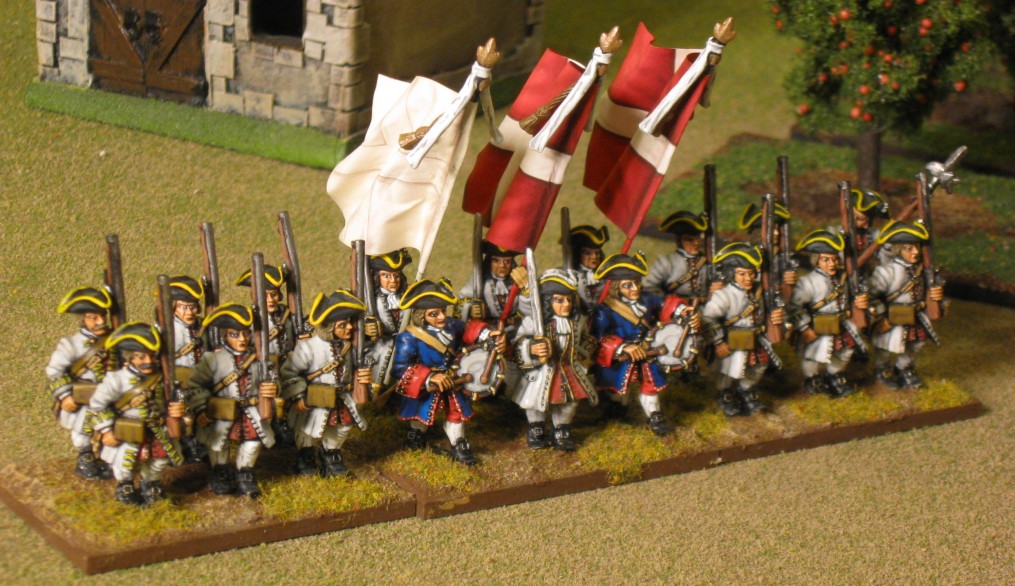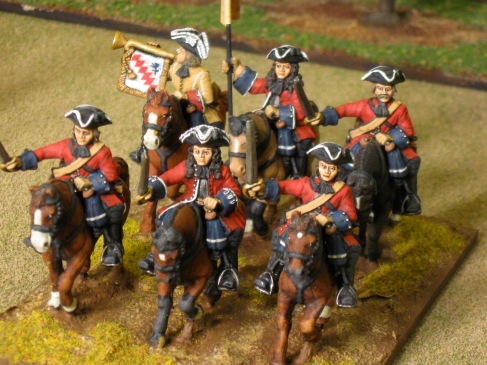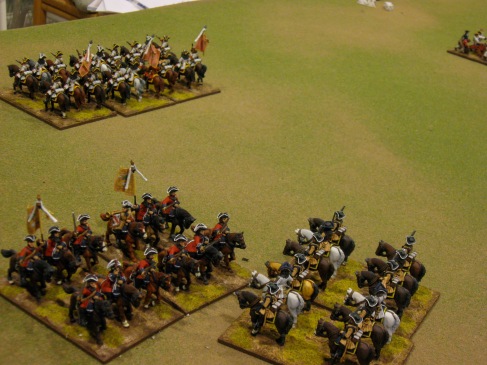The eye candy for this posting is Regiment Courcillon – another French chevaux-leger regiment in the front on the right flank. Figures are by Front Rank and flag by Flags of War.
In part 2 of my write-up of Ga Pa, I hope to give some background on the heart of the game and its most appealing part, the command and control system. I’m drawn to games that put some kind of restrictions on command and control. I play games where you see everything and every unit can do whatever it wants every turn, but I really gravitate towards games where there is much more restriction on what you can do with units. Ga Pa accomplishes this through three mechanisms – limited visibility, limited command actions, and uncontrolled moves.
As a bit of background each general has a leadership and initiative rating. You get the generals randomly as part of the game setup sequence. Leadership is on a scale of 1-5, 5 being better (really good actually) and 1 being pathetic. Initiative is on the same scale. I’ll explain how each of these are used as I go along.
First, there is visibility. Visibility is determined by weather conditions and battle conditions. On a normal day commanders can pretty much see across the battlefield at the start of the game, but as the action develops, the visibility deteriorates. The battle goes through stages of light action, medium action, and heavy action based on the number of units that are engaging in fire combat. Once you get to heavy action, visibility is greatly reduced. At the beginning of each turn one determines which generals can command units based on this visibility. The CnC is always considered in command, but his subordinates, in order to be in command, must either be able to see him, but put into command based on an action of the CnC, or take their own initiative to be in command. To take their own initiative they must pass a die roll against their initiative rating. So to begin a turn, you want to have all your commanders visible or expend actions to put the generals in command.
Second, there is a limited number of command actions for each commander. Each commander gets 4 of them per turn (we mark these with a d4, and use a red d4 for each commander who begins the turn out of command). The commander can do a number of things with them including move himself, take initiative or put a subordinate in command, or order a unit or a group to do things. But, in order to succeed at giving orders, he has to pass a d6 roll against his leadership. (You can see now how awful Louis de Bourgogne with a leadership of 2 and initiative of 1 is.) It’s important to keep your troops together in groups (aligned, facing the same way, perhaps in 2 lines) is. It only takes one command action to move a group or a unit, but as the groups start breaking down much more time is spent trying to get them together.
Third, as things break down you will find that the 4 actions you have are not enough to give orders to all the units in your command. Units that have received no command might still act. Each one rolls against an uncontrolled unit table to see how they behave. In some cases they will take off on their own towards the enemy. Sometimes this works out well, other times it will cause problems. The behavior is dependent on the type of unit, its circumstances, and a random factor based on a roll against the units quality. It works pretty nicely.
Above, the Danish cavalry has already routed the regiment Toulouse and my opponent was unable to control them in his command phase, so they spontaneously charged Courcillon. This was fine for him. I had managed to control Courcillon and hold them. If they had charged spontaneously, because they are French, they would have been disordered by their charge.
These three things (visibility impacted by the intensity of battle, limited control from the commanders, and uncontrolled movement) make for an interesting set of command constraints that makes the commanders spend their time keeping their army organized so it can be effective in battle.




Great blog and the ‘Ga Pa’ rules sound interesting. Would like to see how you compare them to BLB2.
Great looking figures once again!!
Great looking and allways nice to see more about Gå På. Some day I should really get into the rules and pressgang a member of my club to battle it out with. 🙂
Ga Pa are an excellent set of rules, I can’t recommend them enough!
Forgot to say how nice these figures look, good luck with the project. 🙂
Lovely figures! Very interested in you thoughts on Ga Pa as I’m considering them for my WSS project
I’m glad you like the rules 🙂
Must say I am impressed by the look of your miniatures